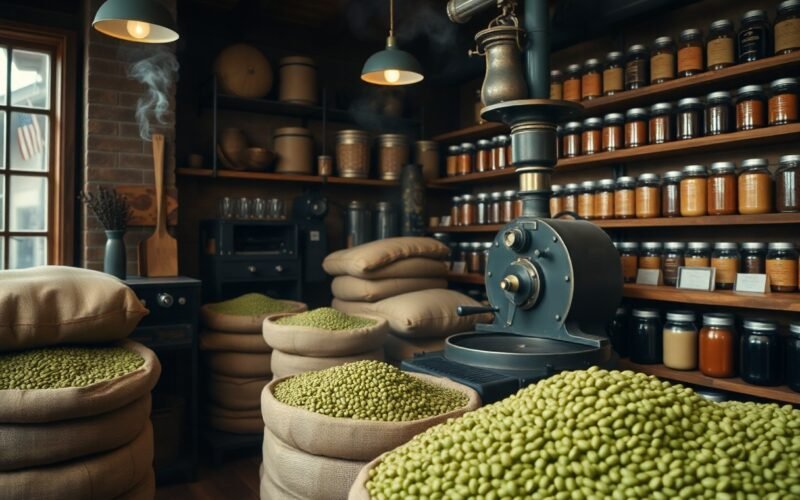Many coffee enthusiasts are unaware of the hidden truths behind the coffee roasting process. You might think you know your favorite brew, but there are important details that roasters keep close to their chests. From the quality of beans used to the impact of roast levels on flavor, this post reveals the insider knowledge that could change your coffee experience forever. For more insights, check out these Coffee Roasting Tips: 5 Expert Secrets for 2025 and elevate your brewing game!
Key Takeaways:
- Understanding the true origin of beans can reveal the quality and ethical sourcing of your coffee.
- Freshness is key; beans can lose flavor quickly after roasting, making the roast date important for taste.
- Roasting levels can be manipulated to enhance certain flavors, but excessive roasting can mask the beans’ natural qualities.
The Truth About Roast Levels: What They Really Mean
Roast levels can be misleading, with many consumers believing that darker roasts equate to stronger flavors. In reality, the flavor profile is influenced more by the bean origin and processing technique than by roast level itself. If you want to explore the nuances of different roast levels, check out this (https://www.tiktok.com/@forfivecoffee/video/7107224281699847470) for some insights into “Unlocking the Secret: The Five Ingredients of The Five Coffee.”
Light vs. Dark: Flavor Profiles Debunked
Light roasts often present vibrant acidity and pronounced fruity notes, while dark roasts showcase deeper, bitter flavors with a heavier body. However, both types can surprise you with their complexity, irrespective of their appearance. Understanding your palate is key, as you’ll discover unique character traits in both light and dark-roasted coffees that can elevate your coffee experience.
The Myth of Freshness: When Coffee is Actually ‘Fresh’
Many coffee drinkers believe that the date on the bag indicates freshness, but that’s often misleading. Beans can lose flavor long before they reach their expiration date. Optimal freshness typically occurs within two to four weeks after roasting, and the way beans are stored greatly affects their longevity.
Coffee beans release carbon dioxide shortly after roasting, which means they’re at their best within a few weeks. Once opened, exposure to oxygen, light, and moisture can significantly degrade the flavors. For optimal taste, store your beans in an airtight container at room temperature and aim to brew them within a month of roasting. You’ll appreciate the rich and nuanced flavors that truly reflect the quality of your coffee.
Sourcing Secrets: Where Your Beans Come From
Your morning cup of coffee starts long before it reaches your mug, originating from the specific regions where each bean is grown. Roasters often prefer beans from regions with particular flavor profiles, leading to a hidden mosaic of taste preferences that can significantly affect quality. These sources can range from well-known coffee-growing regions like Colombia and Ethiopia to lesser-known, smaller farms. Transparency about where your beans come from isn’t common, and each batch’s quality can vary immensely based on factors like climate, altitude, and processing methods used by farmers.
The Dark Side of Fair Trade: What Labels Don’t Tell You
While Fair Trade labels suggest your coffee purchase promotes ethical practices and fair prices for farmers, many nuances remain hidden. Overhead costs for certifications can reduce actual profits for growers, often leaving local farmers feeling the pressure of balancing their sustainable practices with their financial viability. Additionally, not all Fair Trade coffee is created equally; some cooperatives may still face challenges, such as middlemen reducing their profit shares, leading you to question the true impact of your “ethical” coffee choice.
Behind the Scenes: How Coffee Price Fluctuations Impact Quality
The fluctuating prices on the global coffee market can dramatically impact quality on your grocery store shelves. When coffee prices drop, growers might resort to cheaper production methods, sacrificing quality in favor of output. This often leads to a vicious cycle where farmers struggle to hit quotas and compromise on taste just to survive economically. In contrast, when prices soar, you might see an influx of premium quality beans, as farmers are encouraged to elevate their practices. Understanding this cycle allows you to appreciate the complexities behind your favorite brew and the care involved in sourcing it.
Currently, the coffee market is witnessing significant price volatility, with arabica prices fluctuating based on global supply and demand dynamics, seasonal weather patterns, and geopolitical factors. For instance, recently, the price of arabica beans has experienced swings from $1.50 to nearly $2.50 per pound, illustrating how dependent farmers are on these variables. You may notice that during periods of low prices, roasters may offer blends that lack depth or character, as they prioritize cost over quality. This correlation highlights the importance of supporting coffee brands that invest in sustainable sourcing practices—ensuring you enjoy not just a tasty cup, but one crafted with ethical consideration.
The Artisan’s Dilemma: Craft Over Commerce
Balancing quality and profit is a tightrope walk for many coffee roasters. As artisans, they invest hours honing their craft, experimenting with bean origins and roasts to achieve that perfect cup. However, the pressure to scale operations often leads to compromises, resulting in decisions that may sacrifice flavor for cost savings. You might be enjoying a mass-produced blend that lacks the unique character of a truly artisanal roast, all in the name of commerce.
Quality Control: Why Batch Size Matters
Batch size directly impacts the consistency and quality of your coffee. Smaller batches allow roasters to monitor variables closely, ensuring every roast meets their high standards. Larger batches, while tempting for cost efficiency, often lead to uneven results and a less memorable cup. This is where the meticulous attention to detail of artisan roasters shines, as they prioritize excellence over quantity.
The Art of Blending: What Roasters Don’t Share
The art of blending coffee is a well-guarded secret among roasters. It’s not random; master blenders meticulously select beans based on their unique flavor profiles to create a harmonious cup. This process involves countless tastings, adjustments, and an understanding of how different beans interact. In fact, a single blend can involve dozens of distinct coffee origins, each contributing its own scent, sweetness, and acidity, culminating in an experience too complex to reveal on a bag label.
Roasters often shy away from disclosing the specifics because blending requires not just technical skill, but a certain intuition developed over years of experience. You might wonder, for example, how some blends maintain a creamy, balanced finish while others have floral notes. The precise percentages of each coffee type create a complex flavor profile that keeps you coming back for more. With roasting temperatures and times fine-tuned for each bean, the melding of flavors becomes an intricate dance that is as much about art as it is about science. Many roasters spend years perfecting their blends, and sharing those exact methods can dilute their unique selling proposition, making it a closely guarded secret in their pursuit of exceptional coffee.
Equipment Costs 101: The Hidden Expenses of Brewing
Behind every cup of coffee lies an intricate web of equipment costs that go beyond just the price of that shiny espresso machine. From grinders to brewers, every piece of gear boasts a price tag that can significantly impact a roaster’s bottom line. Maintenance, repairs, and the cost of replacements often lurk in the background, driving up expenses you may never consider, ultimately reflected in your daily coffee price.
The Real Price Tag of Your Favorite Coffee Device
Your beloved espresso machine isn’t merely a purchase; it’s an investment often costing thousands. High-end models can range between $2,000 to $10,000, but that’s just the starting point. You’ll also need to factor in additional elements such as grinders, water quality systems, and routine maintenance, which can run into hundreds of dollars annually.
Why Roasters Invest in Equipment You Don’t Understand
Roasters often prioritize investment in specialized equipment that the average consumer may not fully appreciate. For instance, high-quality grinders have precision-engineered burrs that create uniform particle size, impacting the extraction process and flavor profile. This degree of engineering might seem excessive, yet it’s crucial in producing a superior brew.
The hidden intricacies of brewing equipment can seem lost on the average coffee drinker, who may simply equate quality with taste. However, roasters recognize that investing in sophisticated tools, like a temperature-controlled coffee brewer or a dedicated water filtration system, directly enhances flavor clarity and consistency in the cup. For every machine you don’t understand, there’s a story of how that investment can lead to a more flavorful and gratifying coffee experience. Understanding these processes helps to appreciate why that perfect cup of coffee comes at a premium; it’s not just the beans but the meticulous craftsmanship involved in brewing that elevates your coffee experience.
The Flavor Enhancements: What’s in Your Cup
Your morning brew is often more than just roasted beans and hot water. Many coffee roasters may utilize flavor enhancements to manipulate the profile of your cup. Whether through natural extracts, artificial flavorings, or even syrups, these additives can dramatically alter the taste you experience. Curious about how to craft a perfect brew at home? Check out Five Star Coffee Roasters | You don’t need fancy gear to make … for tips that elevate your coffee game!
Additives Revealed: Are They Manipulating Your Taste?
Many coffee brands you trust might be using hidden additives to enhance flavors. You could be sipping on beans that have been treated with flavorings that are not always disclosed on packaging. For example, artificially flavored coffees can pack a punch of unique tastes, but at the cost of authenticity and transparency. Always consider what you’re putting in your cup.
The Role of Aging and Chemical Reactions in Coffee
Aging coffee beans can lead to significant chemical reactions that impact flavor profiles. As beans age, they may develop more pronounced acidity, sweetness, or even off-flavors if not managed properly. This aging process initiates oxidation, which can enhance complex flavor notes but also poses risks if the beans age too long without proper storage conditions.
Exploring the art of coffee aging reveals that it hinges delicately on chemical reactions affecting flavor compounds within the beans. As time passes, compounds like chlorogenic acids break down, evolving into other acids that create a balance of acidity and sweetness in the brew. Aged beans can yield added depth, leading to sweeter, more rounded flavors, but if neglected, they may impart undesirable bitterness. The balance you achieve in coffee aging speaks volumes about the care and expertise of the roaster, influencing the quality of your final cup immensely.
Final Words
Taking this into account, you now possess valuable insights that coffee roasters may prefer to keep under wraps. By understanding the importance of bean origin, roasting consistency, freshness, and sustainability practices, you can make more informed choices in your coffee journey. The next time you sip a cup of coffee, you can appreciate the complexities behind it and elevate your experience, ensuring that your selections are as informed as they are enjoyable.
FAQ
Q: What are the imperative factors that affect the flavor of roasted coffee beans?
A: Several factors play a significant role in determining the flavor profile of coffee beans. These include the origin of the beans, the altitude at which they are grown, the processing methods used, and, of course, the roasting process itself. Each of these elements contributes to the unique characteristics of the coffee. For instance, beans grown at higher altitudes tend to have a brighter acidity and more complex flavors. Additionally, the roast level—light, medium, or dark—affects the final taste, with lighter roasts preserving more of the bean’s original flavors, while darker roasts can introduce smoky or bitter notes.
Q: How do coffee roasters select their beans, and what should consumers look for?
A: Coffee roasters often source their beans through direct relationships with farmers, cooperatives, or importers. They look for specific attributes such as quality, flavor potential, and sustainability practices. Consumers should look for specialty coffee beans that have a unique flavor profile and come with a transparent sourcing story. Understanding the origin, processing method, and any certifications (like Fair Trade or Organic) can also indicate the quality of the beans and the ethical practices behind their cultivation.
Q: Are there any misconceptions about coffee roasting that buyers should be aware of?
A: Yes, one common misconception is that darker roasts contain more caffeine than lighter roasts. In truth, light roasts usually retain slightly more caffeine due to the shorter roasting time. Another misconception is that all coffee should be consumed fresh, which leads to confusion about roast dates. While fresh coffee is important, some roasters believe that allowing coffee to rest for a few days post-roast can enhance its flavor. Lastly, many assume that all coffee beans are created equal, but the quality and flavor can vary immensely based on several factors, including the beans’ origin and processing methods.




